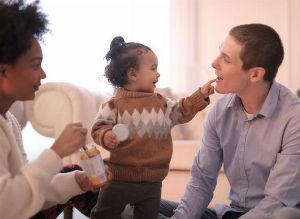Castleman disease in children
Published 1 Mar 2021 • By Charlotte Avril
Castleman disease is a rare disease that affects patients' lymph nodes and immune system.
It affects women and men of all ages, exists in different forms and can have a significant impact on patients' lives. More detailed information can be found in our article entitled "Living with Castleman Disease".
What are the characteristics of Castleman disease in children? Where can patients and their relatives find support?
We tell you everything in our article!

What are the symptoms and treatments for Castleman disease in children?
Castleman disease is rare, and even more so in children. When it is paediatric (when it appears in childhood), the characteristics of the disease as well as the treatments are often the same as those found in adult patients. For more detailed information about the symptoms and treatments of this disease, you can consult our article, "Castleman Disease: Everything you need to know!".
Unicentric Castleman disease (UCD) in paediatric patients:
- Unicentric Castleman disease is more common in children and adolescents than in adults, and can affect women more than men.
- Symptoms of UCD in children are generally similar to those experienced by adult patients.
- Treatment is also the same for paediatric patients with UCD as it is adult patients. Surgical removal of the enlarged lymph node usually has a curative effect in UCD patients. If surgery is not possible, the UCD is considered unresectable (meaning that the lymph node cannot be removed). These patients may therefore need specific treatments used for HHV-8-negative Multicentric Castleman disease (iMCD).
- Complications of the UCD can include paraneoplastic pemphigus or the POEMS syndrome.
Paediatric patients with idiopathic Multicentric Castleman disease (iMCD) and HHV-8-associated iMCD:
- iMCD is less common in children, but around 20% of published cases involve patients aged 18 years or younger. If a child is diagnosed with iMCD, it is essential that he or she be tested for HHV-8 infection. If the test is positive for HHV-8, then the diagnosis is HHV-8-negative idiopathic Multicentric Castleman disease (iMCD).
- Symptoms and treatments of MCD associated with HHV-8 are the same for paediatric and adult patients. You can read our article "Castleman disease and HIV: A focused look at the HHV-8 virus" to learn more about the HHV-8 virus.
Further research is still need to unravel the mysteries of Castleman disease diagnoses in childhood.
What are the difficulties in diagnosing Castleman disease in paediatric patients?
According to the French Health Authority's National Diagnosis and Care Protocol for Castleman disease, certain diagnostic difficulties may arise if the paediatric patient presents:
- Isolated cervical lymphadenopathy: using biopsy (analysis of lymph node tissue), this that may result in a hesitant diagnosis between several types of lymphoid proliferation such as nodular Hodgkin's lymphoma with lymphocytic predominance or progressive transformation of the germinal centres. Rosai-Dorfman disease, Kikuchi-Fujimoto's disease or Hodgkin's lymphoma can be more easily ruled out.
- Primary cervical lymphadenopathy associated with some peripheral lymphadenopathies: differential diagnosis is made upon detection of the initial stages of tuberculosis infection, toxoplasmosis or infectious mononucleosis (IM).
- Unexplained inflammatory syndrome and growth arrest without peripheral lymphadenopathy: based on a conventional imaging procedure, swollen lymph nodes due to Castleman disease can be hard to visualise due to their small size. However, the combined use of PET-CT scans allows easier and faster recognition of the lesion in children with unexplained inflammatory syndrome. Despite the anaemia associated with this syndrome, PET-CT scans are relatively well tolerated.
Finding support and testimonials about Castleman disease in childhood
We know it can be frightening for a parent to learn their child has been diagnosed with a rare disease. On Carenity, you can share your experience with other patients and find comfort, tips, support and motivation to combat CD. Friends and relatives can also join and participate in the discussions, enriching the dialogue and giving us another point of view. If you wish to exchange with our community, you can visit our forum by clicking here.
We also recommend that you get in touch with other relatives of children with Castleman disease. To do so, you can send an email Mileva Repasky (mileva@castlemannetwork.org) of the Castleman Disease Collaborative Network (CDCN), who is the mother of a young patient living with Castleman disease. She can also put you in touch with other families in a similar situation.
On the CDCN website, you can also find many testimonials, especially those of young patients living with CD:
- Katie Repasky: Katie has been fighting Castleman disease since she was 18 months old. Her battle with the disease at times been very difficult and she had to undergo several procedures, scans and hospitalisations, including multiple surgeries. You can read here full story here.
- Joey Incorvia: Joey was diagnosed with Multicentric Castleman (TAFRO syndrome) disease in October 2018. Upon learning that he had a disease that was unknown at the time, his relatives were very worried and almost felt that it would have been easier for him to have cancer since there was a clear treatment and many people are cured of it (or can say that they are cancer-free). You can read his story here.
- Dalton Hennessey: Dalton was diagnosed with Hyaline Vascular unicentric Castleman disease in April 2018, when he was 8 years old. Since diagnosis, he has had to deal with a variety of symptoms and has experienced many ups and downs with his health, which has led him to try different forms of treatment. When Dalton was diagnosed, it was a very frightening time for his family who had to deal with feelings of fear, anger, being overwhelmed and loss. As with many other patients in the Castleman community, the doctor who initially diagnosed Dalton was not very comfortable with the disease, which brought additional anxiety to the family as they faced the unknown. Click here to read his story
- Elyse Driscoll: Elyse was a beautiful and vibrant 13-year-old girl who embodied strength and joy of life. She was diagnosed with unicentric CD and later developed paraneoplastic pemphigus, an extremely rare and serious complication. Elyse's entire family was struggled with her diagnosis. They were told that the disease was "benign", rare, and that surgery would cure Elyse. CD already had such a hold on Elyse that she was unable to overcome it, leaving us on February 3, 2014. You can read her story here.
To go further:
Do not hesitate in visiting the CDCN website (Castleman Disease Collaborative Network) for more information.
You can also join the Castleman disease community on Carenity to share your experience, find support and exchange information with other patients or patients' relatives.
Was this article helpful to you?
Share your thoughts and questions with the community in the comments below!
Take care!

 Facebook
Facebook Twitter
Twitter



